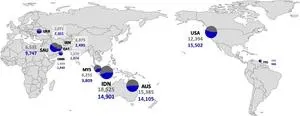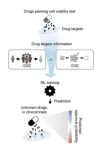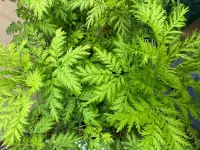(Press-News.org) Computer scientists and mathematicians working in complex systems at the University of Sydney and the Max Planck Institute for Mathematics in the Sciences in Germany have developed new methods to describe what many of us take for granted – how easy, or hard, it can be to fall in and out of sync.
Synchronised phenomena are all around us, whether it is human clapping and dancing, or the way fireflies flash, or how our neurons and heart cells interact. However, it is something not fully understood in engineering and science.
Associate Professor Joseph Lizier, expert in complex systems at the University of Sydney, said: “We know the feeling of dancing in step to the ‘Nutbush’ in a crowd – or the awkward feeling when people lose time clapping to music. Similar processes occur in nature, and it is vital that we better understand how falling in and out of sync actually works.
“Being in sync in a system can be very good; you want your heart cells to all beat together rather than fibrillate. But being in sync can also be very bad; you don’t want your brain cells to all fire together in an epileptic seizure.”
Associate Professor Lizier and colleagues at the Max Planck Institute in Leipzig, Germany have published new research on synchronisation in the Proceedings of the National Academy of Sciences of the United States of America (PNAS).
The paper sets out the mathematics of how the network structure connecting a set of individual elements controls how well they can synchronise their activity. It is a critical insight into how these systems operate, because in most real-world systems, no one individual element controls all the others. And nor can any individual directly see and react to all the others: they are only connected through a network.
Associate Professor Lizier, from the Centre of Complex Systems and the School of Computer Science in the Faculty of Engineering, said: “Our results open new opportunities for designing network structures or interventions in networks. This could be super useful in stabilising electricity in power grids, vital for the transition to renewables, or to avoid neural synchronisation in the brain, which can trigger epilepsy.”
To understand how these systems work, the researchers studied what are known as “walks” through a network in a complex system. Walks are sequences of connected hops between individual elements or nodes in the network.
Associate Professor Lizier said: “Our maths examines paired walks: where you start at one node and set off on two walks with randomly chosen hops between nodes for a specified number of steps. Those two walks might end up at the same node (convergent walks) or at different nodes (divergent walks).
“Our main finding is that the more commonly paired walks on a network are convergent, the worse the quality of synchronisation on that network structure would be.”
This is good news for the brain, where synchronisation is not desirable as it can cause epilepsy . The brain’s highly modular structure means it has a high proportion of convergent walks, which naturally push it away from epilepsy.
“We can even draw an analogy to social media with the echochamber phenomenon,” said co-author Jürgen Jost, whose group also works on social network dynamics. “Here we see sub-groups reinforcing their own messages, via convergent walks within their own group, but not necessarily synchronising to the wider population.”
The findings represent a major step forward in the theory of how the structure of complex networks affects their dynamics or how they compute, such as how brain structure underpins cognition.
DISCLOSURE
The research was supported by the Australian Research Council Discovery Early Career Researcher Award (DECRA) grant DE160100630, the The University of Sydney, Sydney Research Accelerator (SOAR) award, the Alexander von Humboldt Foundation and the NSF Grant Division of Mathematical Sciences (DMS)-0804454 Differential Equations in Geometry. The research used the University of Sydney’s high-performance computing cluster Artemis in generating the paper's results for this paper.
The researchers declare no competing interests.
END
What do neurons, fireflies and dancing the Nutbush have in common?
New paper helps to explain synchronicity
2023-09-08
ELSE PRESS RELEASES FROM THIS DATE:
Drug approvals in clinical trials were correlated with the cells/humans discrepancy in gene perturbation effects
2023-09-08
Developing new drugs is paramount in discovering innovative treatments and preventing diseases. This is vital not only for advancing medicine but also for the overall health and well-being of humanity. Yet, even when drugs demonstrate safety and efficacy in cell and animal models, they frequently encounter hurdles in clinical trials on human.
A single setback for a drug during clinical trials, which involves diverse population groups, can result in significant economic losses. To address this, it is imperative to understand why certain drugs, despite passing the preclinical stages, falter during clinical ...
Unveiling the causes of the 1931 Yangtze River Deluge
2023-09-08
In the summer of 1931, an unprecedented calamity unfolded along the Yangtze River basin in eastern China - the 1931 Yangtze River flood, known as one of history's deadliest natural disasters. This cataclysmic event submerged a staggering 180,000 km2, affected 25 million lives, and tragically claimed over 2 million lives.
Despite its immense societal impact, the origins of this monumental flood have remained largely unexplored, a challenge compounded by the scarcity of historical records and pre-1950s meteorological data in China. Recent access to crucial historical datasets has, however, unlocked the ability to investigate the 1931 Yangtze River flood.
A recent study published ...
Physical activity boosting resources support classroom performance
2023-09-08
DALLAS, September 8, 2023 — This back to school season the American Heart Association and the National Football League (NFL), in collaboration with its 32 NFL clubs, are offering students exciting ways to move more with NFL PLAY 60™. Physical activity is important as students return to the classroom. According to the U.S. Department of Health and Human Services’ 2018 Physical Activity Guidelines for Americans, active kids learn better, focus more, think more clearly, react to stress more calmly, and perform and behave better in the classroom[1].
The ...
New study highlights feasibility and optimization of ammonia-based power generation for carbon neutrality
2023-09-08
Ammonia is emerging as a promising energy source to achieve carbon neutrality due to its inherent carbon-free nature. A recent study, led by Professor Hankwon Lim in the School of Energy and Chemical Engineering and the Graduate School of Carbon Neutrality at UNIST, has evaluated the feasibility of ammonia-based power generation through techno-economic and carbon footprint analyses. The research focuses on an integrated system combining ammonia decomposition and phosphoric acid fuel cells.
The study, conducted using a commercial process simulator, unveils significant findings regarding the efficiency and economic viability of utilizing ammonia ...
UTSA researchers explain plant’s medicinal power against COVID and glioblastoma
2023-09-08
Vibrant green leaves sprout from tall fragrant plants sitting neatly in two rows of terracotta pots in Valerie Sponsel’s UTSA biology laboratory. One floor just above her is the chemistry lab of Francis Yoshimoto, who is extracting the plant’s leaves for medicinal compounds. Soon, the researchers will meet with UTSA researcher Annie Lin, who will test the extracted compounds on cancer cells.
The plant is Artemisia annua, or Sweet Annie, and it contains medicinal compounds. UTSA researchers are studying the plant to understand the bioactive properties of one of these compounds, Arteannuin B, in cancer cells and COVID, the ...
Benchtop NMR spectroscopy can accurately analyse pyrolysis oils
2023-09-08
Benchtop NMR spectroscopy can accurately analyse pyrolysis oils
Pyrolysis bio-oils have the potential to be widely used as alternative fuels but are very complex to analyse
Cheaper, simpler, low-field, or ‘benchtop’, NMR spectrometers were able to accurately quantify key oxygen-containing components of pyrolysis bio-oils for the first time
More accessible analysis could help develop the potential of bio-oils as an alternative to fossil fuels
EMBARGOED UNTIL FRIDAY 8TH SEPTEMBER at 9am UK time 2023 | Birmingham, UK
A team of researchers at Aston University ...
The climate crisis could reshape Italian mountain forests forever
2023-09-08
As a result of the climate crisis, future forests may become unrecognizable. Trees that currently make up European woods may no longer be seen — or they may have moved several hundred meters uphill. Scientists writing in Frontiers in Forests and Global Change have mapped the forests of five vulnerable mountain areas in Italy and modelled the future of these fragile ecosystems.
“If I imagine my daughter walking with me as an old man, in our mountain forests, I can imagine that we can see the initial stage of a profound ...
Disney princesses can be good for a child’s self-image, UC Davis researchers suggest
2023-09-08
Children have loved Disney princesses since Snow White and the Seven Dwarfs premiered in theaters in 1937. While this adoration continues to grow in terms of princess movie ratings, some parents may wonder what effects these idealized images of young women might have on how their children feel about and express themselves.
According to new research from the University of California, Davis, a favorite princess improved — but did not harm — young children’s ...
University of Miami upgrades Atmospheric Chemistry Observatory in Barbados
2023-09-08
The observatory has been used to document the transport of Saharan dust particles across the Atlantic Ocean to the Caribbean, creating the longest-running dust data set in existence. Scientists from many different disciplines use the data to understand how dust particles impact everything from coral reef health to cloud formation and tropical storms.
Through a grant from the National Science Foundation (NSF), the University of Miami Rosenstiel School of Marine, Atmospheric, and Earth Science recently completed a major upgrade to its Barbados Atmospheric Chemistry Observatory (BACO), expanding its capability ...
Beaver activity in the Arctic increases emission of methane greenhouse gas
2023-09-08
The climate-driven advance of beavers into the Arctic tundra is causing the release of more methane — a greenhouse gas — into the atmosphere.
Beavers, as everyone knows, like to make dams. Those dams cause flooding, which inundates vegetation and turns Arctic streams and creeks into a series of ponds. Those beaver ponds and surrounding inundated vegetation can be devoid of oxygen and rich with organic sediment, which releases methane as the material decays.
Methane is also released when organics-rich permafrost thaws as the result of heat carried by the spreading water.
A study linking Arctic beavers to an increase in the release of methane was ...
LAST 30 PRESS RELEASES:
Whooping cough vaccination for pregnant women strengthens babies’ immune system
Dramatic decline in new cases of orphanhood in Uganda driven by HIV treatment and prevention programs
Stopping weight loss drugs linked to weight regain and reversal of heart health markers
Higher intake of food preservatives linked to increased cancer risk
Mass General Brigham–developed cholera vaccine completes phase 1 trial
First experimental validation of a “150-year-old chemical common sense” direct visualization of the molecular structural changes in the ultrafast anthracene [4+4] photocycloaddition reaction
Lack of support for people on weight loss drugs leaves them vulnerable to nutritional deficiencies, say experts
Dogs’ dinners can have greater climate impact than owners’
Are you ready to swap salmon for sprats and sardines?
1.6 million UK adults used weight loss drugs in past year
American College of Cardiology comments on new dietary guidelines for Americans
American Society of Gene & Cell Therapy and Orphan Therapeutics Accelerator partner to advance and commercialize promising rare disease treatments
One in 14 patients having day case surgery have new or worse chronic pain 3 months after their operation
New study highlights link between eviction rates and gun violence
Heatwaves heat up soil but not toxin levels in rice, study finds
Digital modeling reveals where construction carbon emissions really come from
Turning farm waste into water filters
New study shows how the spleen helps the immune system accept a transplant
New Mayo Clinic study advances personalized prostate cancer education with an EHR-integrated AI agent
Researchers identify novel therapeutic target to improve recovery after nerve injury
Microbes in breast milk help populate infant gut microbiomes
Reprogramming immunity to rewrite the story of Type 1 diabetes
New tool narrows the search for ideal material structures
Artificial saliva containing sugarcane protein helps protect the teeth of patients with head and neck cancer
Understanding the role of linear ubiquitination in T-tubule biogenesis
Researchers identify urban atmosphere as primary reservoir of microplastics
World’s oldest arrow poison – 60,000-year-old traces reveal early advanced hunting techniques
Bristol scientists discover early sponges were soft
New study uncovers how rice viruses manipulate plant defenses to protect insect vectors
NSF–DOE Vera C. Rubin Observatory spots record-breaking asteroid in pre-survey observations
[Press-News.org] What do neurons, fireflies and dancing the Nutbush have in common?New paper helps to explain synchronicity







